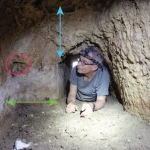Jerusalem, 5 August, 2025 (TPS-IL) — In a groundbreaking study that bridges physics and biology, researchers have uncovered the intricate collective behavior of bacterial species drawn from a unique natural environment in northern Mexico. The discovery not only sheds light on microbial self-organization but may also hold wider implications for understanding collective motion across nature — from flocks of birds to robotic systems.
The research team, led by Professor Joel Stevens and Dr. Rinat Arbel-Goren of the Weizmann Institute of Science, collected microbial samples from the Cuatro Ciénegas Basin in Coahuila, Mexico — a desert region home to rare microbial ecosystems believed to resemble Earth’s environment some 700 million years ago. “This area has fascinated me for years,” said Prof. Stevens, a physicist specializing in biological systems. “Its extreme conditions provide a window into ancient microbial behavior.”
Back in the laboratory, the team worked with Mexican microbiologist Dr. Oscar Gayardo-Navarro to grow and study the bacteria. During his postdoctoral research, Gayardo-Navarro made a puzzling discovery: no matter how thoroughly he mixed the bacterial cultures, they spontaneously separated into intricate patterns under the microscope.
“It wasn’t random,” he noted. “Each species seemed to ‘draw’ a unique pattern — some in hexagons, others in spirals or flowing structures.”
These striking patterns, the researchers found, are the result of a physical process known as “bioconvection.” Bioconvection is a fluid dynamics phenomenon that occurs when large numbers of self-propelled microorganisms — such as bacteria or algae — move in a fluid, typically in response to environmental cues like oxygen or light.
“The bacteria swim upwards toward the surface in search of oxygen,” explained Stevens. “But because they are denser than water, gravity pulls them back down, creating a kind of convection current. It’s a dynamic loop — a constant push and pull between gravity and the bacterial need for oxygen.”
While bioconvection is not a new concept, the study — recently published in the peer-reviewed scientific journal Nature Communications — reveals for the first time how distinct bacterial species generate uniquely shaped patterns. “Until now, most studies examined lab-grown strains in isolation,” said Stevens. “No one really looked at how different species from a single natural community behave when placed together.”
The team took their research a step further by mixing different bacterial species to observe how they would interact. To their surprise, the species maintained spatial separation within the shared environment, even when thoroughly blended beforehand. “We labeled each species with a different fluorescent marker, expecting chaos,” recalled Dr. Arbel-Goren. “Instead, we saw dazzling kaleidoscopic patterns form — each species kept to its own space, like dancers choreographed without ever speaking to each other.”
This separation, the team concluded, did not result from biological attraction or repulsion, nor from differences in cell shape. Rather, it stemmed from subtle differences in swimming behavior.
“Each species has its own rhythm — its own average speed and turning frequency,” said Stevens. “And the greater the difference in these movement traits, the clearer the spatial separation became.”
What’s perhaps most remarkable is the scale of the phenomenon. “We’re talking about microscopic movement — shifts of about two microns,” Stevens emphasized. “Yet these tiny differences manifest in patterns visible to the naked eye, over distances a thousand times larger.”
The discovery has promising practical applications in fields ranging from microbial engineering to robotics. In synthetic biology and industrial microbiology, understanding how bacterial communities self-organize could lead to more efficient bioreactors and customized microbial consortia for fermentation, waste treatment, or biofuel production. Clinically, it could inform strategies to disrupt harmful biofilms or guide the development of targeted drug delivery systems that mimic bacterial movement through bodily fluids.
Beyond biology, the findings offer a model for swarm robotics, where engineers can design autonomous agents — such as drones or underwater vehicles — to self-organize and adapt to complex environments without centralized control, much like the bacteria in the study.
“These results show us that nature has ways of organizing itself we’re only beginning to understand,” said Stevens. “And sometimes, it takes a desert swamp and a microscope to show us just how beautiful physics can be.”





























